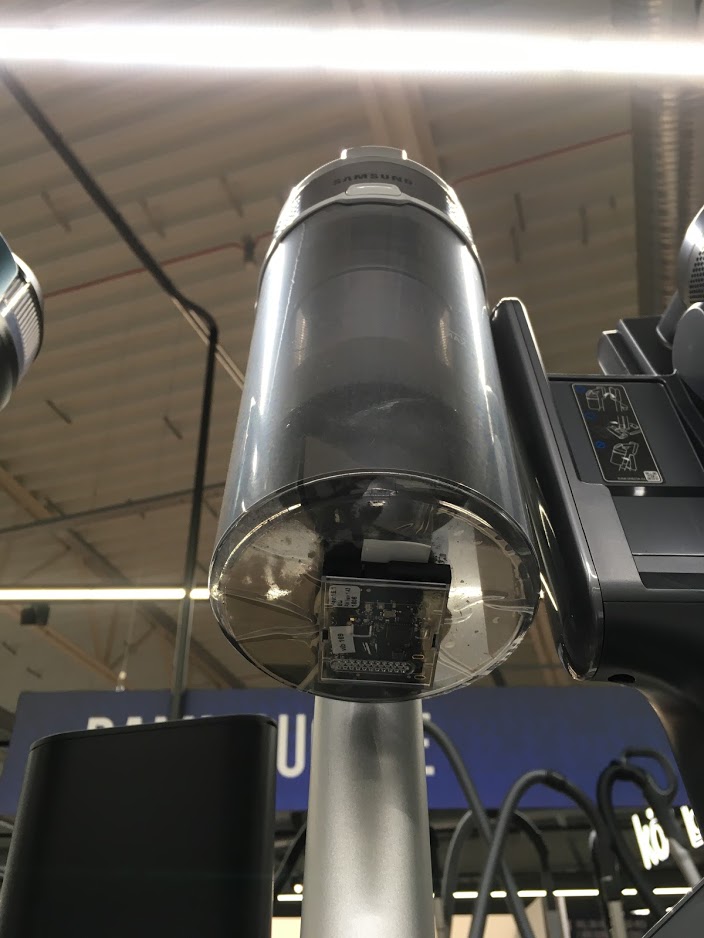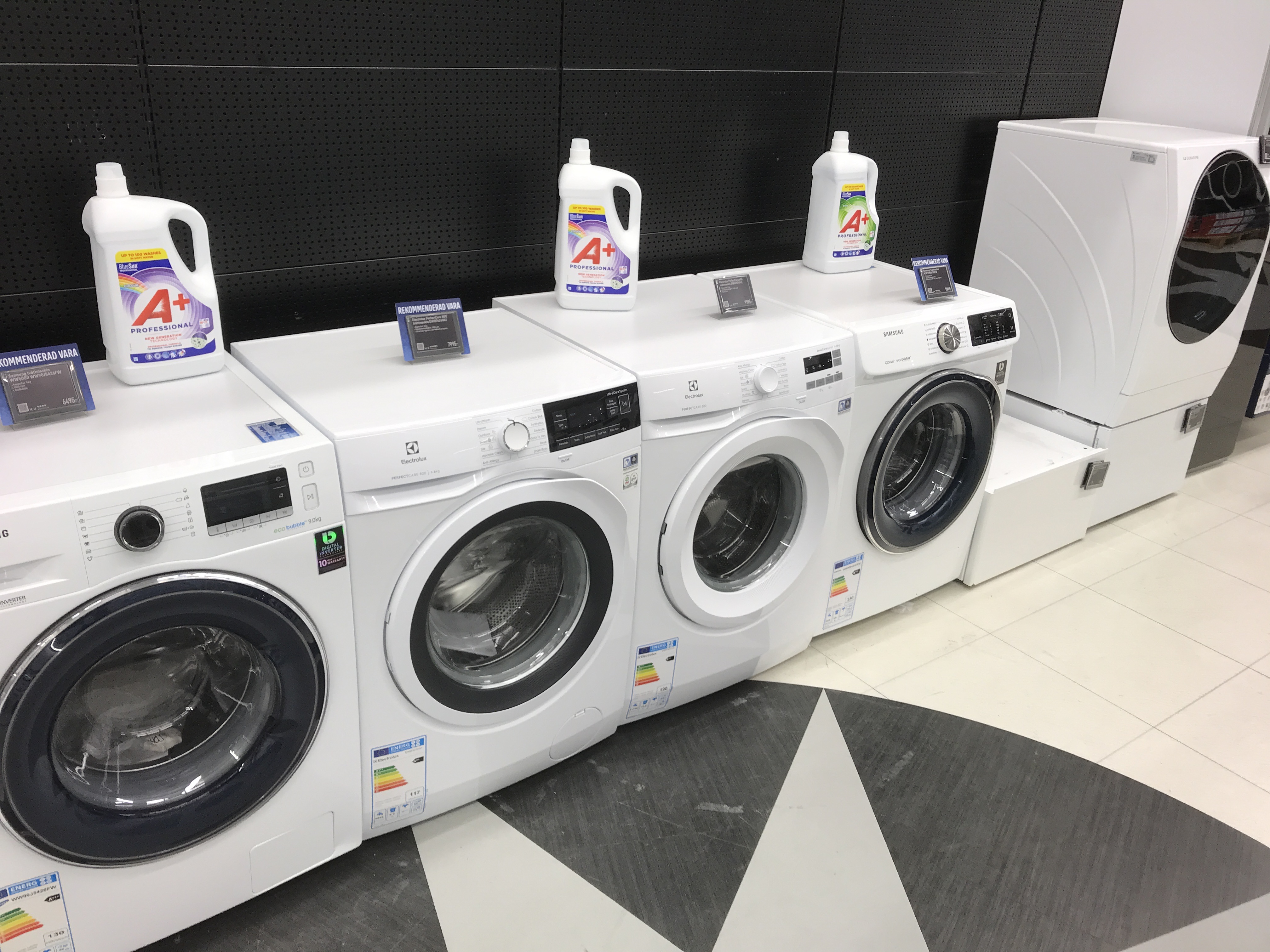Online retailers know a lot about how their customers are navigating their virtual stores. Offline retailers are not so lucky.
Together with consumer behavior experts B:Clarity and a multinational home appliance brand we built a system to help understand customer movement and behavior.
The system consists of wireless sensors that are installed in electronics stores. A few hundred sensors in each store.
There are two types of sensors:
- Vibration sensors. That trigger when someone is trying out a product.
- Light sensors. Trigger when someone is standing in front of a product.
With these sensors, we can see what items are most popular, how it correlates to sales data – and how to take action to improve sales.
But without collecting any personally identifiable information.
This is what the sensors look like:
And this is where they are installed:
Why monitor shoppers?
Online retailers and e-commerce has many ways to gain insight into their customers. Examples include seeing the toplist of searched-for items, and the toplist of searched-for items with no results.
Physical retailers don’t want to be left behind.
So many different ways to monitor shoppers in physical stores have been developed.
Amazon Go stores extensively use cameras to track everything that happens inside their stores.
Many stores provide free WiFi so that they can track their customers.
All these solutions have a big problem: privacy.
Cameras see everything – much more than they need. And this data is collected and stored. Free WiFi hotspots may capture all kinds of traffic.
This is an obvious privacy problem for the shoppers.
But it is not just a problem for the shoppers.
It also creates a major problem for the companies storing the data: personally identifiable data is a liability.
This is why we chose vibration sensors and light sensors. No liability from owning any personally identifiable information.
With only vibration and light, there simply is nothing there to identify individual shoppers.
Our IoT shopper system uses simple sensors: vibration and light.
Understanding shopper behavior
As a shopper, you want to find the best products, and – ideally – pay the lowest possible price.
The retailers and producers have slightly different motivations:
- Brands want customer to buy their products, and not their competitors’
- Retailers want to sell more products
And when the motivations of shoppers, retailers, and brands align, business is made. And the more business, the better for all.
Understanding customer behavior is key to improving the experience for everyone.
The sensors detect when people are looking at items. And they report this immediately, so that we can see in real-time where shoppers are.
But the data is also posted to a backend database. This lets us to more in-depth, off-line analysis of the data, see how it changes over time, and how it improves the sales.
To be able to cover large electronics stores, we use a wireless IoT mesh network.
Electronics stores are large. But a wireless sub-GHz IoT mesh network can easily cover the entire area.
Why use a wireless IoT mesh network?
A wireless mesh network is a wireless network that automatically extend its range.
The Thingsquare IoT mesh network solution uses so-called sub-GHz wireless technology that has way better range than traditional WiFi or Bluetooth.
But even with a longer range, it is not always enough.
Electronics stores can be very large. And there is plenty of metal inside them that hampers the wireless coverage.
A mesh network is the ideal technology in these situations:
Coverage. Electronics stores can be huge. With a mesh network, we can cover it all.
It just works. No network planning is needed.
Easy to install. Just put each device where it should be.
Easy to maintain. If there are issues with coverage, just add extenders as needed.
Robustness. If something changes, the network will automatically adapt and overcome.
This is what the wireless mesh network typically looks like:
In this deployment, the mesh network used one access point and two extenders. Most device are able to reach the access point directly, but some chose to talk to one of the extenders.
Battery life
The sensors are equipped with batteries: one coin-cell battery each.
The Thingsquare IoT mesh system is tailored for extreme low-power operation. Extreme low-power operation in this case means that the sensors can go for several months one a single charge.
For example, the sensors are automatically turned off at night, to conserve their precious power.
But most importantly, the Thingsquare system continuously collects power consumption data from each and every sensor.
This data lets us see the exact behavior at any given time: are there any sensors that behave in a way that require their batteries to be replaced earlier? The Thingsquare system knows the answers to this, and alerts us if this would be the case.
Connectivity
The ioT mesh network is connected to the Internet via a 4G modem. The network maintains a stable encrypted connection to the backend system so that the devices always can be reached.
If the Internet connection would go down at any point during the deployment, the devices hold off from reporting their data until the Internet connection is restored.
With this technique, no data is ever lost.
Technical details
The software used in the project is the Thingsquare IoT platform, with its wireless mesh network and the backend controller in the cloud:
- Thingsquare’s IoT mesh Sub-GHz radio technology
- Thingsquare’s IoT mesh IPv6 networking and the RPL mesh routing protocol
- TLS end-to-end encryption
- Channel hopping to avoid problematic radio channels
- Cloud deployment on AWS
The project uses the following hardware components:
- The Texas Instrument CC1350 wireless System-on-a-Chip (which is an earlier version of the current CC1352R SoC that we currently use)
- An MPU9250 accelerometer to detect vibrations
- An OPT3001 digital ambient light sensor to measure changes in lighting conditions
Conclusions
This project is a multi-year collaboration between a Thingsquare customer and a major multinational home appliance brand. Thingsquare is the technology partner, providing our wireless IoT technology and expertise to make the project come true.
Are you looking to build an IoT project with extreme requirements in terms of scale, coverage, or power consumption? Get in touch with us today to see how we can help you make your project come true!
 By Adam Dunkels, Thingsquare CEO
By Adam Dunkels, Thingsquare CEO













